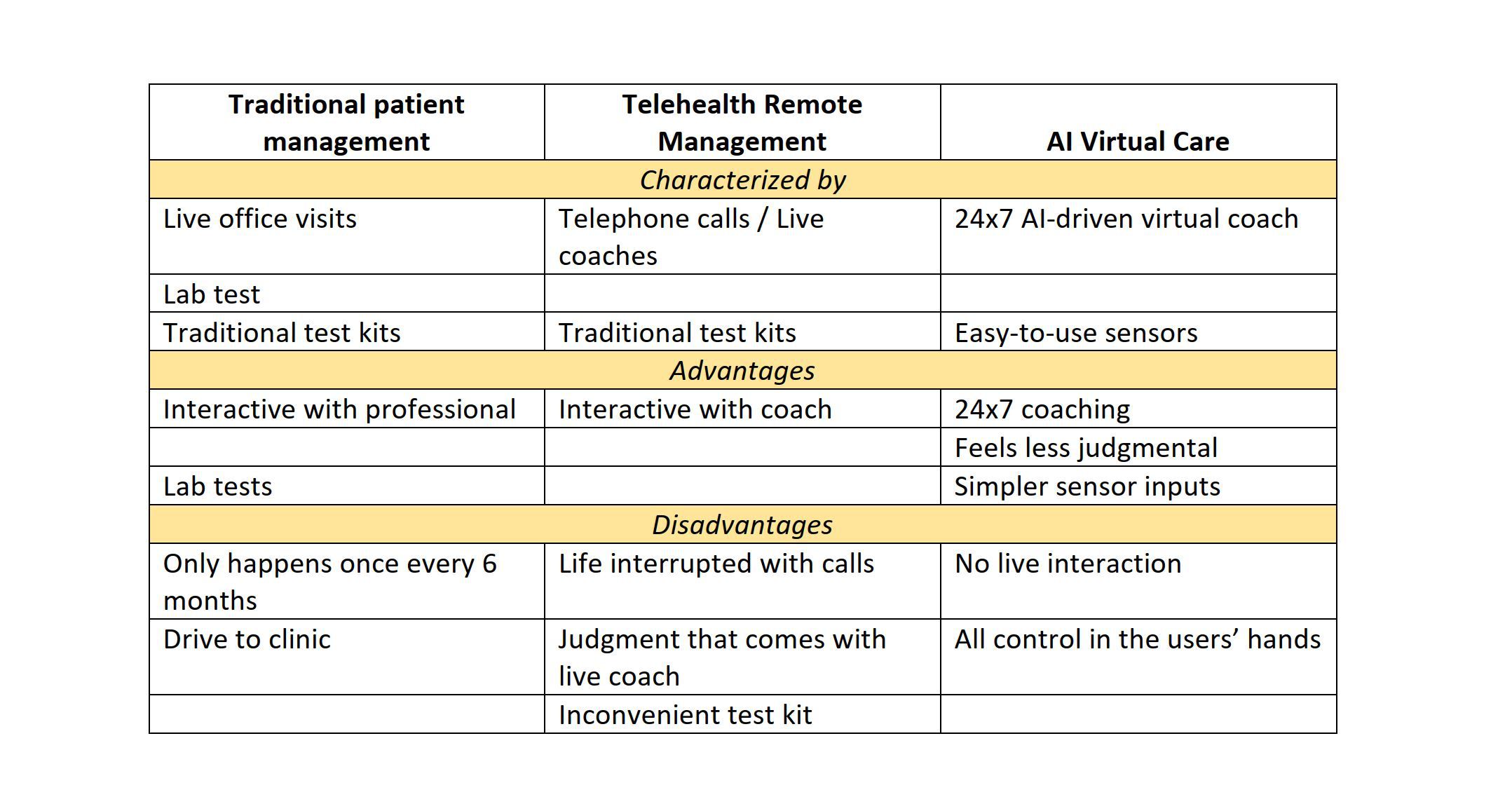For years, physicians have been managing their patients, but are only able to see them in the clinic. Then technology-enabled telehealth to attempt to remotely manage them to compliance. Now AI virtual care is enabling people to take ownership of their health. This is even more important during the COVID-19 pandemic.
Never before have we seen such an emphasis on the need for people with chronic conditions like diabetes to control their condition and do it without routinely exposing themselves to higher risk situations like clinics. We have heard over and over that people with diabetes are at higher risk for COVID-19. What is really true is that people with uncontrolled diabetes are at higher risk due to the resulting compromised immune system that comes with high blood sugar levels (1). The problem is that the majority of people with diabetes are not controlling their condition.
Table of Contents
Traditional Care
Our standard of care for people with diabetes to control their blood sugar has not dramatically changed in many years. Physicians encourage people with diabetes to come to the clinic for a routine A1c test (the clinical measure of blood sugar) and an office consultation or visit with diabetes educators. Once the person with diabetes leaves the clinic, they are again on their own for 6-12 months to follow the suggestions of the physician, nurse, and educator.
Telehealth
People have good intentions to follow their doctor’s orders but often fail once they leave the clinic. In fact, diabetes has become the most expensive chronic condition due to complications from the uncontrolled condition. Enter the internet. The internet and cellular technology-enabled telehealth and remote management in the early 2000s, and we thought we found a solution for patients when they leave the clinic—let’s try to remotely manage the patients. Most often in diabetes, that remote management includes a telehealth connection to the patient’s blood glucose kit.
Telehealth remote monitoring offers an advantage over traditional care by monitoring the patient outside the clinic and offering people advice during the time between clinic visits. Unfortunately, there are multiple challenges with telehealth solutions. Those challenges include:
- A live healthcare professional can only interact with a person periodically
- The monitoring devices do not provide the consumer experiences people desire today, so the devices sit in a bathroom while the patient is outliving their life
- Typical chronic care telehealth is connected to a device such as a test kit, which is not always with the person
- A live telehealth coach can feel invasive and like “big brother” watching over the shoulder
- If the telehealth coach is not part of the clinic, the patient may get confused as to who is caring for them—the coach or their physician.
AI Virtual Care
The next step beyond telehealth remote management is AI Virtual Care. The data is clear that people are more often taking healthcare into their own hands. People have spent $50 billion dollars on wearables to monitor their own health in the last year (3), and over 300,000 health apps exist in the Apple app store (4). The strong computing power that 81% of Americans own in our smartphones makes self-care more of an opportunity (5).
Why are people taking healthcare into their own hands? It comes down to information access. Previous generations had less access to information and relied completely on trained healthcare professionals in the clinic to tell them how to manage their health. These same generations also did not have access to the variety of home sensors we now have available–from simple blood pressure cuffs to EKGs, and activity sensors. With this new access to information, people no longer feel obligated to routinely visit a clinic or speak to a random person over the phone.
AI virtual coaching takes advantage of the power of smartphones and sensors to enable people to take ownership of their chronic conditions. An AI coach is app-driven without a live coach behind it. While some people will want to speak to someone live, many people are much more comfortable getting their feedback from the AI coach. AI coaches can suggest better ways to manage a condition, simply remind you of the right behaviors, and adjust to the person’s motivation and knowledge level.
The AI coach may also be connected to sensors that are easy to use versus the typical traditional and telehealth monitoring sensors. A simple glucose sensor could replace a glucose monitoring kit or an EKG patch could replace a complicated Holter monitor. An AI coach can also integrate other relevant information to help the user. For example, location and activity information on the phone may become part of the AI coach’s inputs.
The best AI Virtual Care will include both an app and sensors that are providing a consumer experience that enables a person to receive their assisted care while they are living their life. In this way, people can manage their condition without taking special time out of their routine. AI Virtual Care enables people to Own Their Life™ versus their condition owning their life.
Because 60% of Americans are managing a chronic condition, there is a very large and diverse population of people who need assistance. This means that it is unlikely that one solution is going to be right for everyone. Just as some people thrive on having their exercise class delivered to them via a daily routine on their computer and some people thrive on a live class of twenty people, chronic condition management needs to be delivered in a variety of methods for everyone to move forward. In one recent study, 55% of people are comfortable with AI coaching and another 26% are open to this change.
Traditional care with physicians is a critical component of all chronic condition management. However, people with a chronic condition need to manage that condition the other 99.9% of their time outside the clinic. To meet this need, employers, providers, and health plans must consider that AI Virtual Care is quickly becoming the new standard beyond Telehealth remote management.
References:
- https://www.jdrf.org/coronavirus/
- https://www.alliedmarketresearch.com/wearable-technology-market
- https://liquid-state.com/mhealth-apps-market-snapshot/
- https://www.pewresearch.org/internet/fact-sheet/mobile/









